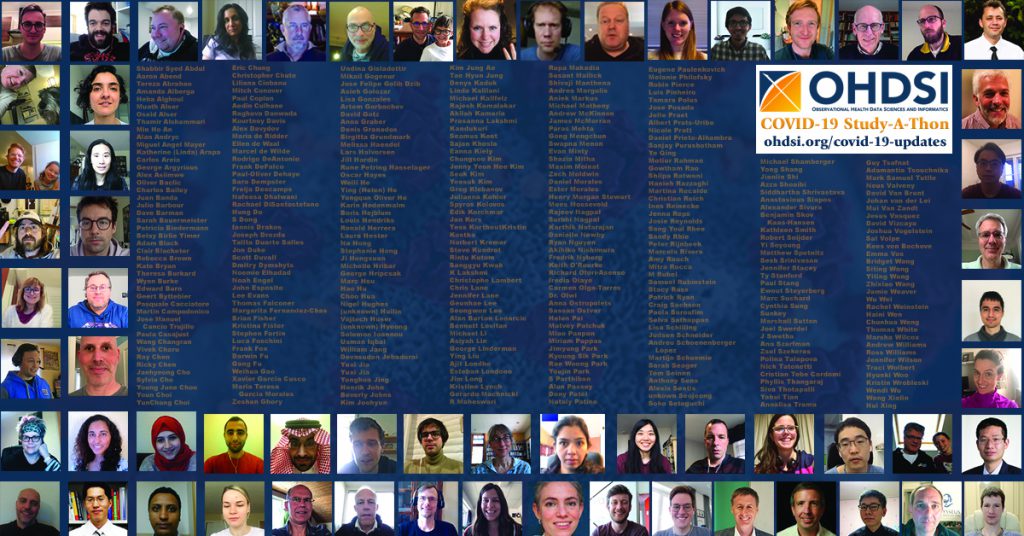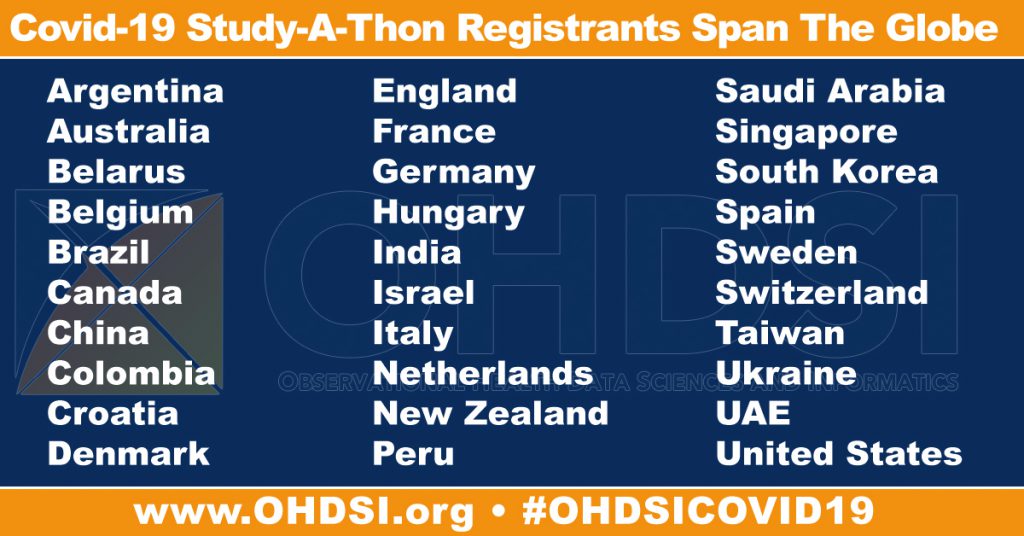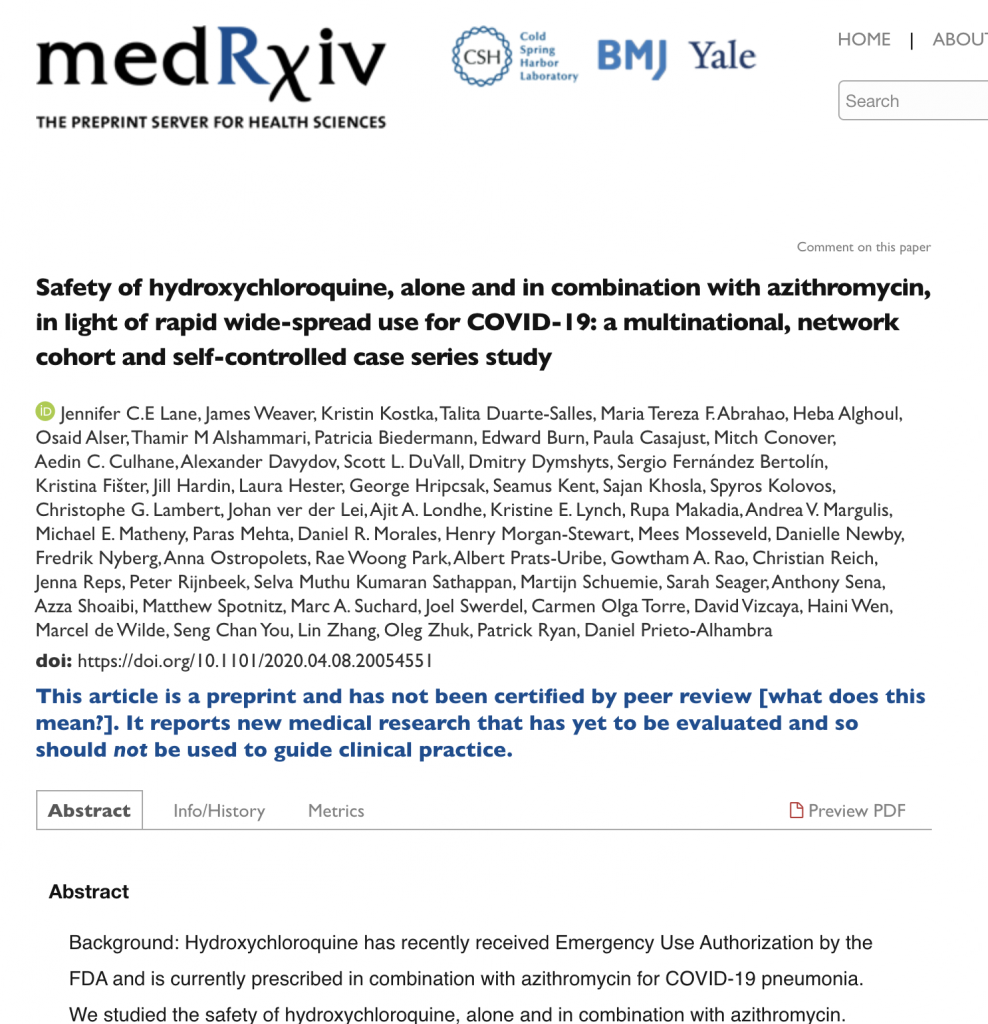LINKS: COVID-19 Updates Page • COVID-19 Global Closing Call
 The time was meant for highlighting OHDSI capabilities, not testing them.
The time was meant for highlighting OHDSI capabilities, not testing them.
The hours were meant to sharing global research, not sharing in global research.
The Observational Health Data Sciences and Informatics (OHDSI) community held a COVID-19 global, virtual study-a-thon March 26-29, believing that a network of people who valued both collaboration and open science could make a meaningful impact on the current global pandemic.
How? Nobody was quite sure in the moment, but they were confident they would figure it out.
“We chose an ambitious path and relied on our community and infrastructure to lead the way,” said Patrick Ryan. “In simple terms, efforts within our community over the past 88 months set the foundation for OHDSI’s most important and impactful 88 hours.”
The Observational Health Data Sciences and Informatics (OHDSI) community, by definition, is a multi-stakeholder, interdisciplinary collaborative to bring out the value of health data through large-scale analytics. In plainer terms, it’s a community of people who volunteer their time and talents for the shared goal of improving healthcare through observational research.
A global network of OHDSI colleagues planned to celebrate recent research initiatives and discuss future efforts during the annual European Symposium at Oxford University in late March. The symposium was canceled due to the rapidly spreading COVID-19 virus; in its place, the organizing committee planned a study-a-thon, which OHDSI has experienced significant success with several times over.
The twists?
The COVID-19 data was limited (a significant issue for an observational data science network), the needs were immediate, and everybody was staying home.
Those factors would be a hard stop to most, but the virtual OHDSI community has thrived on overcoming obstacles, and there was never a more crucial time to do so again.
Daniel Prieto-Alhambra, Professor of Pharmaco- and Device Epidemiology at Oxford, remembers his OHDSI conversion occurring during one of the afore-mentioned study-a-thon events in 2018. This one had nothing to do with viruses or antibodies; it was about the safety profile of varied knee replacement procedures and ultimately produced a paper published in Lancet Rheumatology.
While that data didn’t affect COVID studies 15 months later, the impact of the event stayed with Prieto-Alhambra. He presented on it during the 2019 U.S. Symposium, led another one in Barcelona to focus on rheumatoid arthritis and volunteered to host the global community for the 2020 European Symposium.
“We were thrilled to bring the OHDSI community to Oxford, and we were excited about some new aspects, including new tutorials,” Prieto-Alhambra said. “It was crushing to cancel it in the moment, but we quickly looked ahead and saw an opportunity to make the most of our time and talents. From that moment, we never looked back.”
88 hours.
That was the time between the global kickoff and closing calls, both of which have combined for more than 1,600 views on YouTube (the entire set of calls and presentations is available here). More than 330 people from at least 30 nations registered to collaborate in the event, offering their services in areas like literature review, protocol development, study execution, etc.
 Peter Rijnbeek, Associate Professor Health Data Science at the Erasmus University Medical Center in the Netherlands, has a history of bringing together leaders in observational health data science. He hosted the 2019 OHDSI European Symposium, and is leading the recently created EHDEN consortium, which is building a large-scale, federated network of European data sources for the discovery and generation of real-world evidence.
Peter Rijnbeek, Associate Professor Health Data Science at the Erasmus University Medical Center in the Netherlands, has a history of bringing together leaders in observational health data science. He hosted the 2019 OHDSI European Symposium, and is leading the recently created EHDEN consortium, which is building a large-scale, federated network of European data sources for the discovery and generation of real-world evidence.
He took a leadership role once again; his Erasmus team set up the virtual platform and created 17 different ‘teams’ that held varied roles throughout the event.
This setup, for example, enabled a group focused on phenotype development to work collaboratively, while also having the ability to connect with teams inside the characterization, estimation and prediction groups as well. When needed, there were support teams for literature review, data support, study design and more.
Your standard study-a-thon might just send various groups to different areas within a shared space. At different points in these 88 hours, that ‘space’ might have had collaborators from both hemispheres, working simultaneously at different points of a 13-hour time period. Breakfast in South Korea, dinner in Spain and lunch in New York City, all taking place while determined volunteers seek answers during a global crisis.
“OHDSI has always been about people working together to solve common goals, and I am proud our team helped to make this event possible,” Rijnbeek said. “We brought the OHDSI world to Erasmus MC in person last year, but it was even more important to bring them together virtually right now.”
88 hours.
It is unrealistic to think OHDSI’s monumental goals could be accomplished in such a limited time. Early work needed to be done developing an infrastructure for both the meetings and the OHDSI technical platforms, which happened mainly due to the sustained efforts of Lee Evans, Anthony Sena, and James Wiggins. Beyond that, many of the prioritized questions that would become the primary focus of the four days were determined beforehand.
Community involvement was sought in suggesting such questions, but a group that truly believes in collaborative open science knew this was a time to reach outside the circle. Stakeholders around the world reached out to national governments, public health agencies, and health-related institutions to learn what the most critical questions were right now. That feedback, as well as a literature review process that began days before the study-a-thon, helped the core team provide a framework for the four days.
There was a clear desire to create a multi-nation characterization study of COVID-positive patients, even if the data size was more limited at the moment.
There was a need to understand the overall safety profile of different drugs being considered in COVID treatment; that included hydroxychloroquine, which became an international fascination after achieving small success in France and then being touted by President Trump on multiple occasions.

The first preprint from the study-a-thon came from the largest study ever done on the safety profile of hydroxychloroquine.
There were crucial prediction questions, which could help healthcare workers make important triage decisions, including which patients would require hospitalization. As each day passed, the challenges facing overwhelmed medical facilities globally were becoming abundantly clear.
Preliminary work with data was necessary as well. Christian Reich led the vocabulary team to develop COVID-related updates on the standardized vocabularies, while Kristin Kostka and Greg Klebanov were among many collaborators working with different sites on either data conversion or analysis support. Seng Chan You and Rae Woong Park collaborated with the South Korean HIRA, which worked with OHDSI to run packages against a more robust set of COVID data than anywhere in the United States. A handful of American institutions, including Columbia and Stanford, signed on to provide deidentified COVID data as well.
“The data owners chose to donate their data for use in these critical studies simply because they want to help,” Kostka said. “They share our belief in the power of the OHDSI community, and because of that trust, we are able to generate the world’s largest observational studies to help inform decision-making in this major public health issue. I think that’s the coolest thing imaginable, and I am so proud to be part of this effort.”
Laying the groundwork was the necessary warmup for the sprint that was to come — and the marathon that would follow
88 hours.
It began Thursday, March 26, at 7 am in Oxford, as Prieto-Alhambra welcomed an international community of people to this unique and critical initiative. A panel including Ryan, Rijnbeek and George Hripcsak — chair of the Department of Biomedical Informatics at Columbia University, the coordinating center for OHDSI — discussed the long journey from the formation of OHDSI to this moment, and what they believed could be accomplished over four days.
Subgroup calls immediately followed to set the course for their respective work plans. Teams within characterization, estimation and prediction studies discussed study questions, varied responsibilities, and timetables over the four days; those timetables were dependent on the phenotype group, which had to develop standard cohorts that could be used within all studies.
It was the ultimate team environment.
And the clock was now ticking.
88 hours.
Leadership from institutions including Oxford, Erasmus, Columbia, UCLA, Ajou University, Janssen Research and Development, and IQVIA helped put this event in motion, but OHDSI empowers collaborators at different stages of their own journey to make important contributions.
Jennifer Lane, an orthopedic surgeon pursuing her PhD at Oxford, led the literature review efforts and co-authored the manuscript for the largest safety profile on hydroxychloroquine ever executed. Ed Burn, a recent PhD graduate from Oxford, led the characterization team; he had also served as lead author for the Lancet Rheumatology paper on knee replacement.
Ross Williams, Cynthia Yang and Aniek Markus are each PhD students at Erasmus, and they are co-authoring a prediction study that could help critical hospitalization and triage decisions healthcare workers are making on a daily basis.
Anna Ostropolets is a PhD student at Columbia who shared in the leadership of the phenotype team and presented on the 114 validated & reviewed cohorts developed and distributed by the team during the closing call.
Many others within academia contributed to the initiative, while global stakeholders from both industry and healthcare agencies provided critical efforts, ranging from protocol design to data support.
“The OHDSI community has an open approach to everything,” said Lane, co-lead author of the hydroxychloroquine study, which had its preprint recently posted on MedRxiv. “It is based upon clear communication, that all contributions are valuable. Everyone is playing to their strengths, which means that the combined effort is precision in many areas that would be incredibly difficult or impossible within one research group or institution. I have met people who will shape the way I work in the future, both through their leadership and their willingness to help me learn novel research approaches.”
Many registrants were newcomers to the OHDSI process, and who found the idea of a COVID-19 study-a-thon either inspirational and interesting. Their contributions may have been more limited than others over the 88 hours. Some from that group already found their footing in the community and joined studies either developed or brainstormed over the four days.
Each person who takes that step strengthens the community.
88 hours.
You’ve seen that number before? OK, here are a few new ones.
Between the 12 global huddles, there were more than 100 collaborator calls and 13,000 chat messages over 17 concurrent channels (different teams). More than 10,000 publications were reviewed and 355 cohort definitions were defined to lead to the drafting of nine protocols and the release of 13 study packages.
“The real-world evidence we are generating to inform decision-making in this global pandemic is the most important thing to come from these four days,” Ryan said. “But when I step back and reflect on what a community of volunteers achieved in this collaborative setting is humbling. We had a shared goal that mattered to everybody, but OHDSI has a way of attracting good people that you enjoy being around. I don’t take that for granted. The people that make up our community are our greatest strength.”
It’s easy to have that positive feeling on Day 1, or as you reach the close, but to have it in the middle of a four-day marathon is a testament to the energy created organically. The Friday night chat messages and Saturday morning team calls mattered — in that short a time, it all matters — and maintaining focus and enthusiasm powered the process from start to finish.
The 88th hour.
The global closing call was broadcast live to a global audience and provided a series of presentations about how OHDSI arrived at this moment. It was an opportunity to celebrate shared efforts, announce study designs and preliminary findings, and plan for the future.
When Prieto-Alhambra signed off for the final time, COVID-19 did not go away.
OHDSI won’t either.
The efforts continued immediately. As protocols continue to be designed or improved, data partners work to run studies and generate evidence. The first manuscript was submitted for peer review two weeks after the final signoff, and more are in the works.
Generating real-world evidence to improve healthcare has been the OHDSI mission since it officially formed in 2014. This has been a passion project for a global community that expands in both people and analytic capability each year.
Nobody saw this moment coming. But it did, and OHDSI was more ready for it than even the most optimistic collaborator could have imagined.
There were critical discoveries in the first six years, and there are many more to come — including some that will hopefully aid global efforts against COVID-19 in the near future.
But those 88 hours stand as a defining moment for OHDSI, and they are a glimpse of this community’s potential on the journey ahead.
by Craig Sachson
